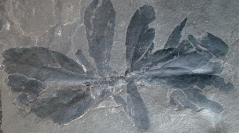

 Comptes Rendus Palevol
18 (8) - Pages 913-924
Comptes Rendus Palevol
18 (8) - Pages 913-924The first reconstructions of glossopterids interpreted this Gondwanan group as arborescent, deciduous plants, with leaves and reproductive structures inserted on short shoots, which were arranged on long branches. The leaves are its most abundant organ in the fossil record, but they are mainly found isolated. The arrangement of the leaves as terminal whorls or tight spirals has been the most accepted phyllotaxis hypothesis. The few examples of leaf impressions preserved in connection with axes correspond mainly to leaves of Glossopteris Brongniart, and mostly without clear evidence of the type of insertion. Several specimens of Gangamopteris McCoy leaves attached to axes from the Bajo de Véliz Formation (Latest Carboniferous–Earliest Cisuralian) facilitate reconstruction of the foliar arrangement of the genus, to date known mostly from isolated leaves. The available evidence from the new specimens confirms a variation from well-spaced to dense helical insertion of the leaves without forming true whorls, and discards the early notion that they were mainly clustered apically on short shoots in a similar manner to the extant Ginkgoales.
Gangamopteris, Upper Paleozoic, leaves, phyllotaxis, Gondwana, Argentina